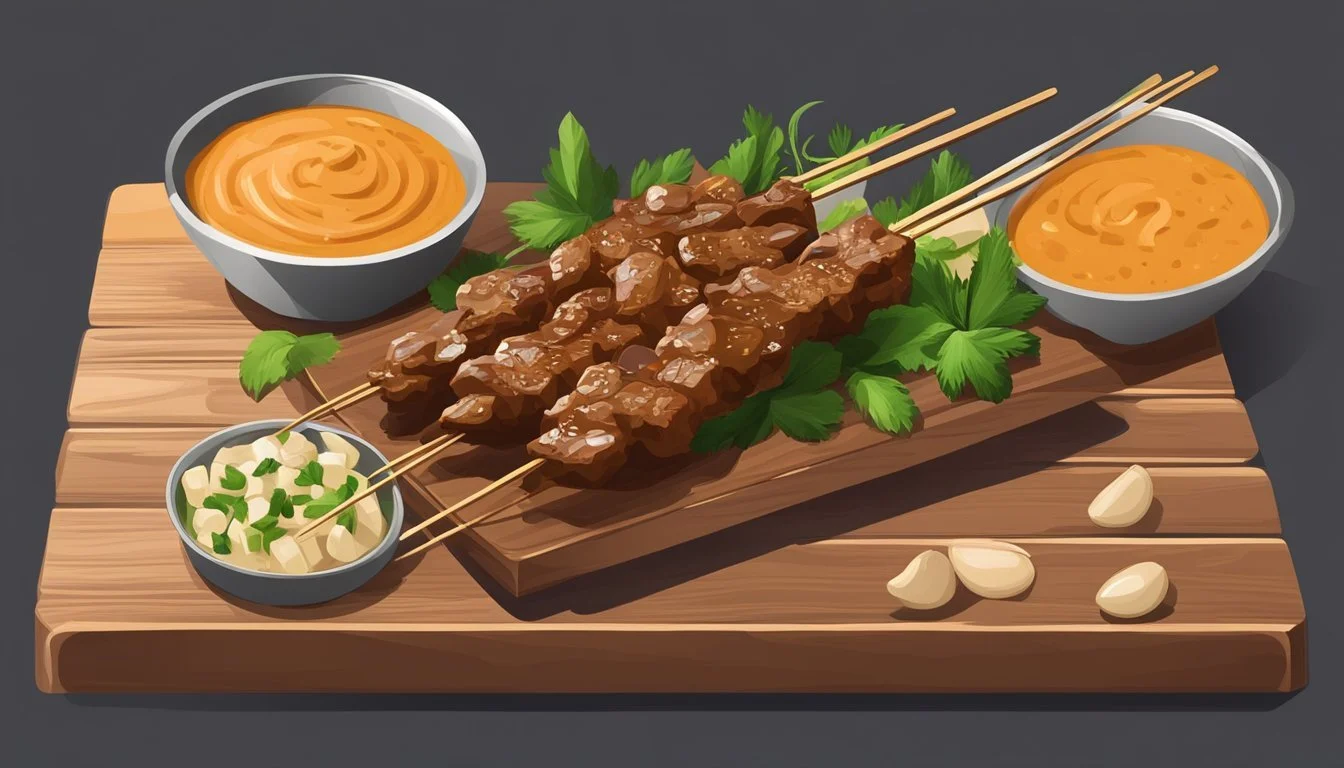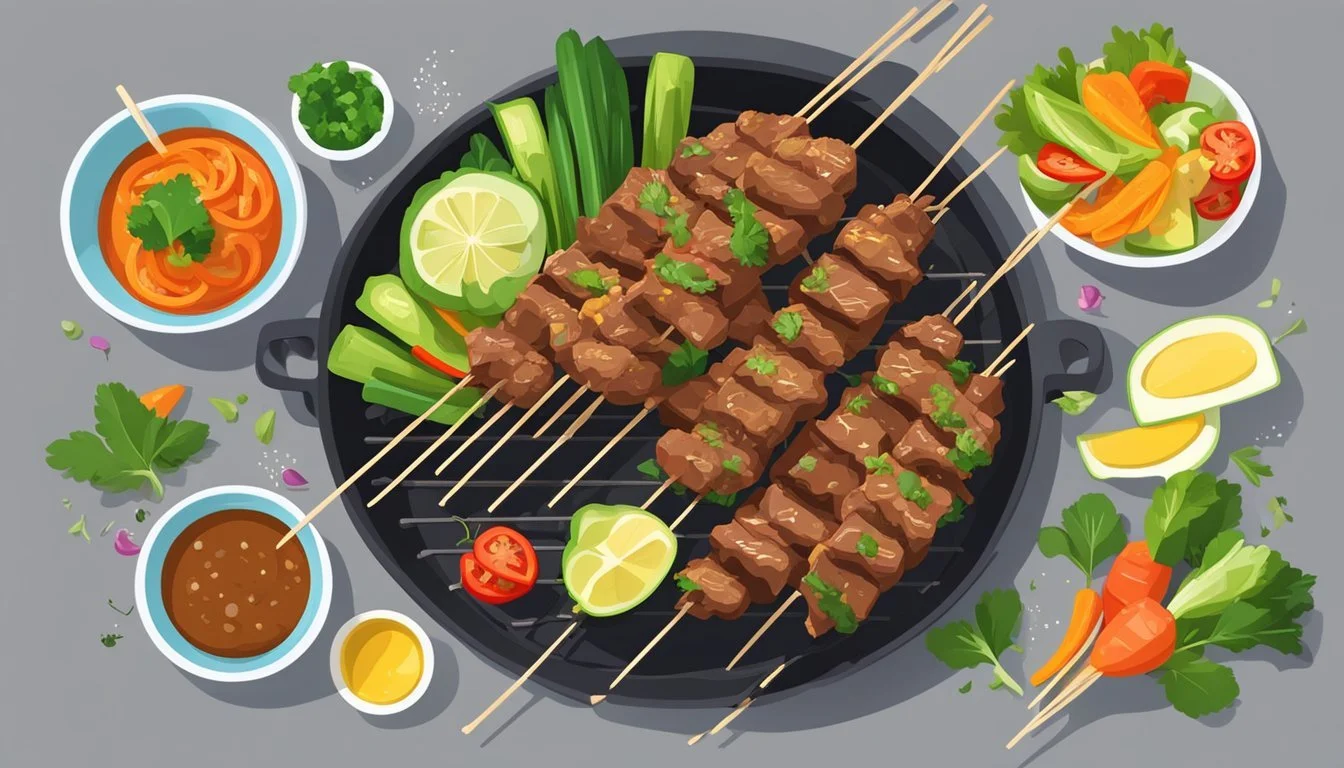How Long Does Beef Satay Last?
Storage Tips and Shelf Life
When it comes to relishing the flavors of beef satay, knowing how long it lasts can be crucial for both safety and taste. Cooked beef satay typically lasts for 3 to 4 days when properly stored in the refrigerator. It's essential to place the beef in an airtight container to maintain its freshness and prevent any cross-contamination.
For those looking at extending the shelf life, freezing is an excellent option. Properly stored in a freezer-safe container or bag, beef satay can last for up to three months. Thawing should be done in the refrigerator overnight to ensure safety and preserve the integrity of the meat and its seasoning.
Understanding the shelf life of your beef satay helps in effective meal planning and avoids food waste. This post delves deeper into the best storage practices, signs of spoilage, and tips on reheating to enjoy your beef satay just as deliciously as the day it was made.
Beef Satay Overview
Beef Satay, a popular dish in Southeast Asia, is well-loved for its marinated and flame-grilled skewered meat, often served with a flavorful peanut sauce. This dish not only promises a delicious taste but also carries significant cultural heritage.
Origin and Cultural Significance
Beef Satay originated in Indonesia but has since spread throughout Southeast Asia, including Singapore and Thailand. It is revered as both street food and a festive appetizer. The cultural significance of satay ties to communal eating and celebration. It showcases regional culinary techniques and flavors, making it a staple at gatherings. Each region offers its variant, highlighting local spices and marinades.
Defining Satay
Satay involves marinated meat, typically cut into small pieces, skewered, and grilled. The marinade usually includes ingredients such as soy sauce, garlic, ginger, and various spices, creating a balance of sweet, salty, and aromatic flavors. It is commonly served with peanut sauce, enhancing its taste. Though beef is widely used, other meats like chicken and lamb are also popular. This versatility and simplicity contribute to satay's global popularity.
Key Ingredients and Alternatives
Beef satay typically requires a blend of specific ingredients to achieve its signature flavor. The following sections detail both common ingredients and suitable alternatives.
Common Ingredients
For authentic beef satay, beef and a well-crafted marinade are essential. Popular beef cuts include steak such as sirloin or tenderloin. The marinade often contains a mix of soy sauce, fish sauce, lime juice, brown sugar, and vegetable oil. These ingredients tenderize and flavor the meat.
Garlic, ginger, and lemongrass add aromatic depth, while coriander and cumin offer a warm spice profile. For a rich taste, coconut milk and peanut butter are common, particularly in the accompanying peanut sauce. This sauce might include additional elements like dark brown sugar, tamari, sriracha, and curry powder to enhance flavor complexity.
Substitutes and Variations
For those needing alternatives or wanting to experiment with variations, several swaps can maintain the dish's essence. Chicken or pork serve as effective substitutes for beef. Tamari can replace soy sauce for a gluten-free option. If avoiding peanuts, almond butter or sunflower seed butter works well in place of peanut butter.
When lacking ingredients like lemongrass or fish sauce, use lime zest and a mix of soy sauce and anchovy paste. For sweeter or different flavor profiles, maple syrup or dark brown sugar can replace brown sugar. A touch of curry powder can substitute cumin for a different twist on the spice blend. Adjustments like these keep the dish flavorful while catering to dietary needs or ingredient availability.
Preparation Techniques
Carefully preparing beef satay ensures that the meat is flavorful, tender, and cooked to perfection. This involves a few key steps: marinating the beef, skewering it properly, and choosing the right cooking method.
Marinating Process
Marinating the beef is crucial for flavor and tenderness. Flank steak, skirt steak, or sirloin steak are excellent choices.
Combine ingredients like soy sauce, ginger, garlic, brown sugar, and coconut milk to create a savory marinate. Cinnamon and vinegar can be added for additional depth. Marinate the beef for at least 1 hour, but for best results, let it sit overnight in the refrigerator. This allows the flavors to fully penetrate the meat and helps it to remain tender during cooking.
Skewering Methods
Using skewers ensures even cooking and easy handling. You can choose bamboo skewers, wooden skewers, or metal skewers. If using bamboo or wooden skewers, soak them in water for at least 30 minutes before use. This prevents them from burning on the grill.
Cut the beef into thin, uniform strips, roughly 1 to 2 inches wide. Thread the strips onto the skewers in a way that allows for even cooking. Avoid packing the meat too tightly, as this can cause uneven cooking and impede the absorption of the marinade.
Cooking Methods
There are several ways to cook beef satay, each bringing out different flavors and textures. The grill is the most traditional method. Preheat a charcoal or gas grill to medium-high heat, and lightly oil the grates.
Place the skewers on the grill and cook for 2-3 minutes per side or until the meat is charred and cooked through. Alternatively, use an outdoor grill, barbecue, griddle pan, or broiler to achieve similar results. For indoor cooking, a skillet or oven broil can be used.
Each method has its unique advantages, with grilling offering a smoky flavor. Adjust cooking times based on the thickness of the beef and desired doneness, ensuring the meat remains juicy and flavorful.
Flavor and Texture
Beef satay combines delicious flavors with a tender texture that makes it a standout dish. This section will explore ways to enhance its taste and achieve the perfect texture.
Enhancing the Taste
Using a flavorful marinade is critical to infusing beef satay with a rich taste. Ingredients like soy sauce, garlic, ginger, and sesame oil provide depth. Adding a sweet component such as honey or brown sugar balances the savory notes.
Fresh spices like cumin or coriander can elevate the dish further. Some cooks recommend marinating the beef for at least 30 minutes, but longer marination, such as overnight, allows flavors to penetrate more deeply. Basting the meat with additional marinade during grilling enhances its flavor profile.
Serve with a side of peanut sauce, which adds a creamy, nutty dimension. Garnish with chopped peanuts or fresh herbs like cilantro for an extra burst of flavor.
Achieving Desired Texture
Tender texture in beef satay hinges on proper marination and cooking methods. Marinating the beef in acidic components like pineapple juice can help break down the meat fibers, making it more tender.
Cooking methods also play a crucial role. Grilling the skewers over medium-high heat for about 5-7 minutes per side ensures that the beef remains juicy. Avoid overcooking, as this can make the meat tough.
Resting the beef for a few minutes after grilling allows the juices to redistribute, resulting in a more succulent bite. Cutting the meat against the grain before marinating can also contribute to a tender texture.
Storage and Shelf Life
Beef satay, when stored properly, can maintain its quality and safety for consumption over several days or even weeks. Proper refrigeration and freezing techniques are crucial for extending its shelf life.
Refrigeration Guidelines
Beef satay, whether marinated or fully cooked through, should be refrigerated promptly to ensure safety and freshness. Store beef satay in the refrigerator at 40°F (4.4°C) or lower.
Freshly prepared beef satay can be kept in an airtight container or wrapped tightly with plastic wrap or aluminum foil. Under these conditions, it generally lasts for 3 to 5 days. Leftover beef satay from a fully cooked recipe should follow the same storage guidelines, also lasting 3 to 5 days in the fridge. Pre-marinated beef satay, if uncooked, should ideally be used within 2 days.
Important: Always label containers with preparation dates to monitor freshness and avoid consuming outdated food.
Freezing and Thawing
To extend the shelf life of beef satay, freezing is an effective option. Marinated but uncooked beef satay can be frozen for up to 3 months in vacuum-sealed bags or heavy-duty freezer bags, ensuring minimal air exposure to prevent freezer burn.
Fully cooked beef satay can be stored similarly, extending its shelf life to about 2 to 3 months. When freezing, layout skewers flat in a single layer on a baking sheet until frozen, then transfer to freezer-safe packaging.
When ready to use, thaw frozen beef satay in the refrigerator overnight. For faster thawing, submerge the sealed package in cold water, changing the water every 30 minutes, and cook immediately after thawing.
This approach ensures the ingredients and flavors are preserved, maintaining the quality and safety of your beef satay. Proper labeling of frozen containers with dates is essential for tracking storage duration and ensuring optimal freshness.
Health and Nutrition
Beef satay is not only delicious but also packed with various nutrients. The health benefits and nutritional content can vary based on the ingredients and preparation methods. It's important to consider both the nutrient profile and any dietary restrictions when consuming this meal.
Nutrient Profile
Beef satay offers a variety of nutrients. A typical serving includes:
Protein: Essential for muscle repair and growth.
Iron: Helps in the formation of red blood cells.
B vitamins: Supports energy production and brain health.
Nutrient Table for Beef Satay (per serving):
Nutrient Amount Calories 200-250 Protein 20-25g Fat 10-15g Carbohydrates 5-10g Iron 10-15% DV
These values can vary depending on the specific ingredients used and portion sizes.
Considerations for Dietary Restrictions
When preparing or consuming beef satay, certain dietary restrictions must be considered.
Gluten-Free: Ensure soy sauce is gluten-free.
Low Carb: Opt for a peanut sauce without added sugars.
Vegetarian/Vegan: Substitute beef with tempeh or tofu and choose a vegetarian-friendly marinade.
Low Sodium: Use low-sodium versions of soy sauce and fish sauce.
By making these adjustments, people with specific dietary needs can enjoy beef satay while adhering to their restrictions. Careful selection of ingredients can make this meal versatile and accessible to a wider audience.
Serving and Presentation
Beef satay presented with thought and care can elevate the dining experience. Pay attention to accompaniments and plating techniques to enhance flavor and aesthetics.
Accompaniments
Peanut Sauce: A classic pairing, typically made with ingredients like peanut butter, lime juice, and sriracha sauce. It balances the savory flavors of the beef with its nutty and slightly spicy profile.
Fresh Garnishes: Consider cilantro, crushed peanuts, and thinly sliced scallions or shallots. These add fresh, crisp textures and vibrant colors, bringing out the asian flavors of the dish.
Sides: Serve with jasmine rice or cucumber salad to complement the rich flavors. A light ginger or lime dressing can enhance the refreshing factor without overpowering the main dish.
Spicy Dipping Sauce: For those who enjoy an extra kick, a side of spicy dipping sauce made with fresh ginger and sriracha sauce can be a great addition.
Plating Techniques
Skewer Arrangement: Place the skewers in a fan shape or circular pattern for visual appeal. Ensure the beef satay pieces are evenly spaced.
Sauce Placement: Drizzle the thai peanut sauce over the skewers or serve it on the side in a small bowl. This adds a neat and sophisticated touch.
Garnish Finish: Generously sprinkle crushed peanuts and chopped cilantro over the beef. Scatter thin slices of scallions for a bit of height and color contrast.
Plate Composition: Use a large, neutral-colored plate to make the vibrant elements pop. Arrange the sides thoughtfully, keeping enough space to avoid overcrowding while allowing the dish to stand out.
Pairing and Cuisine Integration
Beef satay can be perfectly paired with a variety of beverages and seamlessly incorporated into different meals, enhancing the dining experience. The right pairings intensify its flavors, while creative meal integration broadens its culinary reach.
Suitable Pairings
Wine Pairings: For an enhanced experience, try pairing beef satay with full-bodied red wines like Bordeaux, which can bring out the rich flavors of the meat. Alternatively, a medium-bodied red wine or creamy stout complements the satay's tenderness. For a contrasting pairing, consider a sparkling wine or light beer to add a refreshing note.
Other Beverages: Crisp beverages such as light beers and sparkling water can cut through the richness, offering balance. On the non-alcoholic front, iced tea or cucumber water provide a refreshing match without overpowering the dish.
Incorporation into Meals
Appetizers: Beef satay makes an excellent appetizer, especially when served with a peanut sauce that's smooth and slightly spicy. For gatherings, arrange satay skewers on a platter with various dipping sauces like sweet chili or curry.
Main Course: Incorporate beef satay into larger meals. Add it to a spinach salad with a tangy dressing, or serve alongside sticky rice for a fulfilling Thai-inspired dish. It can also be integrated into wraps or bowls with fresh vegetables and noodles, making it versatile for light or hearty meals.
Multicultural Cuisine: Beef satay brings a touch of street food flair to any table. Combine with other Thai dishes, such as chicken satay or green curry, to offer a varied, culturally rich dining experience. It can also be served as a side to more elaborate Western meals, providing an exotic twist.
Food Safety Considerations
When preparing and storing beef satay, maintaining food safety is crucial to prevent foodborne illnesses. Proper handling and storage techniques ensure the freshness and safety of the beef and other ingredients used.
Safe Handling Practices
It's essential to follow safe handling practices when dealing with beef for satay. Always wash hands, utensils, and surfaces with hot, soapy water before and after contact with raw beef. Using separate cutting boards for meat and other ingredients like vegetables is advisable to avoid contamination.
Keep beef refrigerated at or below 40°F (4.4°C) and use it within 1 to 2 days after purchase. If marinating, do so in the refrigerator, not at room temperature, and avoid using the marinade as a sauce unless it has been boiled.
Preventing Cross-Contamination
Cross-contamination is a major concern when preparing beef satay. To prevent this, store raw beef separately from ready-to-eat foods. Use sealed containers or plastic wrap to cover the beef in the refrigerator and ensure that juices from raw meat do not come into contact with other foods.
When cooking beef satay, use different utensils for raw and cooked beef. If skewers are used, ensure they are either pre-soaked if wooden or cleaned thoroughly before use. To reduce risk, marinate beef in sealed containers and avoid letting raw meat touch other ingredients in the marinade.
Maintaining these practices helps ensure that beef satay is both delicious and safe to eat, minimizing the risk of foodborne illnesses.
Culinary Tips and Tricks
Preparing delicious beef satay involves key practices to enhance flavor and avoid mishaps. Focusing on expert advice and avoiding common mistakes can make your next beef satay dish a success.
Expert Advice
Marinate Effectively: Beef satay benefits greatly from marination. Use a mixture of dark soy sauce, pineapple juice, and spices to achieve a tender and flavorful outcome. Marinate the thinly sliced beef for at least a few hours, but overnight yields the best results.
Grill Techniques: Whether using an outdoor grill, indoor grill, or griddle pan, preheat to high heat before cooking. The beef should be cooked for 5-7 minutes per side. This ensures a slightly charred exterior while keeping the inside juicy. A charcoal grill can add a distinct smoky taste.
Peanut Dipping Sauce: Complement your beef satay with a rich peanut dipping sauce. Combining peanut butter, coconut milk, soy sauce, and spices in a saucepan and heating it gently adds a delicious layer of taste. Serve it warm for the best pairing with the grilled meat.
Common Mistakes to Avoid
Underestimating Preparation: Skewers need to be soaked in water for at least 30 minutes before use to avoid burning. Additionally, not preheating your grill can result in uneven cooking and sticking.
Overloading the Grill: Avoid crowding the grill with too many skewers at once. This can lead to inconsistent cooking and steaming rather than grilling. Leave space between each skewer for proper airflow and heat distribution.
Improper Slicing: Ensure that the beef is thinly sliced against the grain. This helps in maintaining tenderness and ease of eating after grilling. Thick slices can lead to tough, chewy meat.
Skipping Rest Time: After grilling, let the skewers rest for a few minutes. This allows the juices to redistribute within the meat, enhancing the final taste and texture.
Paying attention to these details ensures your beef satay is not only flavorful but also visually appealing and enjoyable to eat.











